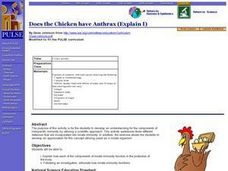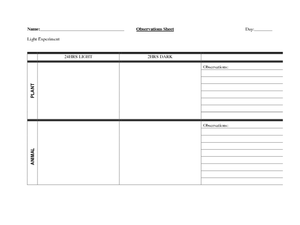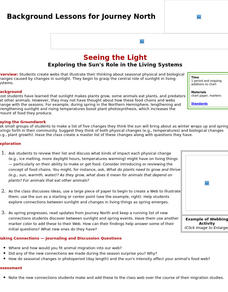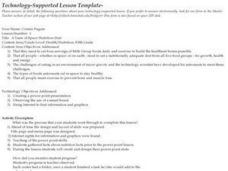Curated OER
Walk a Mile in Albatross Shoes
Students recognize the correlation between the trash they dispose of around their school and the environmental hazards that face wildlife, specifically the Laysan albatross. They determine three ways that they can help the albatross chicks.
Curated OER
Mud in the Water
Students build a soil erosion model to study the importance of soil conservation. They investigate how land forms from both constructive and destructive forces.
Curated OER
What Do I See Now When I Picture Saturn?
Students complete their study of Saturn and its moons. They reflect in writing what they have gathered from the lessons. They draw pictures and add captions to them. They share their work with the class.
Curated OER
Different Types of Orange Juice Contain the Same Amounts of Vitamin C?
Students measure and compare the amount of vitamin C in orange juice samples. They discover the effects of different factors on the concentration of vitamin C. They participate in an experiment to test the orange juice.
Curated OER
How Can We Target Tumor Angiogenesis?
High schoolers define and use new vocabulary. They review the process of angiogenesis and describe the characteristics of a tumor. They discover how chemotherapy targets these types of cells.
Curated OER
Preparing for the New Haven Public School Science Fair Through Environmental Science
Students discover what type of effect that pesticides have on earthworms. They use three different types of pesticide and examine the external and internal effects that each have on earthworms. They maintain earthworms in habitats...
Curated OER
Animals Piece by Piece
Students sort organisms and objects into groups according to their parts and describe how the groups are formed.They identify body parts of animals from puzzle pieces, assemble the puzzle, and name the animal.
Curated OER
Mythical Animals
Learners create imaginary animals by assembling pictures of body parts from pictures of real animals. This is one of three linked tasks. The others are "Who's Parts Do I Have?" and "Animals Piece by Piece."
Curated OER
Does the Chicken have Anthrax (Explain I)
High schoolers explain how each of the components of innate immunity function in the protection of the body. Following an investigation, they articulate how innate immunity functions.
Curated OER
Cloning and Related Issues
Eighth graders research information on cloning and the surrounding issues online. They analyze the issues surrounding cloning and present their point of view with supporting details in a Powerpoint presentation.
Curated OER
Organisms – Their Needs
Students compare and contrast different organisms characteristics. In this life science lesson plan, students design an experiment about plants and animals needs. They collect data and write their conclusion about the experiment.
Curated OER
Cycling Through Controversy
Students research different perspectives and debate environmental issues. They consider different viewpoints when proposing solutions.
Curated OER
Exploring the Sun's Role in Living Systems
Students create graphic organizer webs that illustrate their thinking about seasonal physical and biological changes caused by changes in sunlight. They identify the central role of sunlight in living systems.
Curated OER
From Seed to Plant
Students adopt seeds, recording their observations as they draw their seeds, germinate them, and plant their seedlings using the hydroponic method. Students maintain journals recording their germination experiments.
Curated OER
Worm Bin Project Data Exchange
Students work collaboratively to exchange data with their peers (groups of students at other schools) about their worm bin project. They discuss differing findings and hypothesize reasons for these differences.
Curated OER
Analyzing Journey North Maps
Students analyze what's happening and interpret why it's happening as the season progresses.
Curated OER
Composting
Eighth graders collect data from Bottle Biology compost columns and record using Excel spreadsheet.
Curated OER
Using Our Natural Resources Wisely
Students understand how ground water can be recycled to maximize its usage and begin to think about ways conservation can help Kansas preserve its natural resources in other areas - soil, minerals, and clean air.
Curated OER
Investigate Non-native Neighborhood Invasion Species
Learners investigate non-native species that are invading local or state environments. They choose one species to research and report on.
Curated OER
The Wildland/Urban Interface Dilemma
Students examine all sides of the issues surrounding wildland fire. Groups assume the roles of different people who must decide what to do about a fictitious wildfire. They have a discussion to analyze the issue. A good, real life lesson!
Curated OER
A Taste of Space Nutrition Unit
Second graders make a power point presentation about space nutrition and health.
Curated OER
Mapping My Community
Ninth graders are introduced to GPS technology. They complete fieldwork as they visit a specific area of their community to identify and map types of land use in the surveyed area. They use the collected data to create a digital map.
Curated OER
Endangered Biomes
Students compare data from two proposed strategies on how ot best preserve the diversity of plants and animals. They complete a worksheet and share theirviews with the rest of the class.
Curated OER
What's Hiding in the Air?
Fifth graders conduct experiments to study the effects of invisible air pollutants including one with a bean plant. They examine methods of invisible air pollutants.
Other popular searches
- Human Growth and Development
- Plant Growth and Development
- Child Growth and Development
- Human Growth & Development
- Fetal Growth and Development
- Animal Growth and Development
- Body Growth and Development
- Human Growth Development
- Child Growth Development
- Child Growth & Development

























